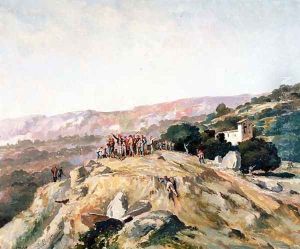Josep Berga Boix Paintings
Josep Berga i Boix was a notable Catalan painter, illustrator, and writer, born on May 16, 1837, in La Pobla de Lillet, a small town in the comarca of Berguedà, Catalonia. His artistic inclination was evident from an early age, and he pursued his passion for art throughout his life. Berga i Boix was a contemporary of the cultural and political Renaixença movement—a Catalan renaissance that sought to revive and promote Catalan identity, language, and culture during the 19th century.
Trained at the Escola de la Llotja in Barcelona, an institution renowned for its arts and crafts education, Berga i Boix was particularly influenced by the Romanticism movement. His body of work includes landscape paintings, historical scenes, and illustrations that often depict the natural beauty of Catalonia and the customs and traditions of its people. His style is marked by a meticulous attention to detail and a love for the Catalan landscape, which he captured with a sense of realism and sometimes idealization.
In addition to his painting, Berga i Boix contributed to Catalan literature and illustration. He worked on various publications, providing illustrations for books and magazines. This included his work for the illustrated weekly magazine 'L'Esquella de la Torratxa,' where his caricatures and drawings became well known. His literary contributions were also significant, as he wrote articles and essays on art and regional culture, which helped to fortify the cultural identity of Catalonia during a time of burgeoning national consciousness.
Berga i Boix's legacy extends beyond his artistic output. He was an influential figure in the cultural life of Catalonia, actively participating in the intellectual circles of his time and advocating for the preservation of Catalan heritage. He also served as the director of the Museu Comarcal de Manresa from 1898 until his death.
Josep Berga i Boix passed away on October 23, 1914, in his hometown of La Pobla de Lillet. Today, he is remembered for his contributions to Catalan art and culture, with works displayed in various museums and collections throughout Catalonia. His commitment to the cultural renaissance of his homeland has cemented his place as an important figure in the history of Catalan art.
